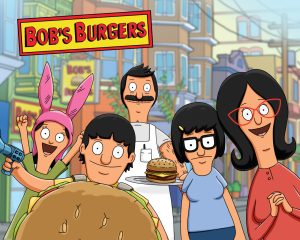While fans of the popular American show, Bob’s Burgers may be highly knowledgeable of characters, narratives, and long-running jokes, there is lesser known knowledge about where the show is actually animated. South Korea is an answer that may surprise many, which begs the question: how many American shows or networks outsource their material to be animated abroad, and what might be some possible effects?
For one thing, it should be known that the largest driving force for creating material overseas is lower cost of production. Outsourcing was popularized in the 1970s when ABC, CBS, and NBC couldn’t meet demand for new episodes of popular shows such as Scooby-Doo and Fat Albert. Korean artists then proved to be technically proficient and quick, and became the new source for many projects (Mayes). Decreased costs are due to the fact that employees in places such as Soul do not have as many protected creative and working rights, therefore allowing for physical and financial exploitation. This poses an ethical dilemma about sacrificing fair working conditions for the sake of larger profit.
A large problem which Korean studios have also faced in recent years is a hesitance to turn from paper animation to digital. This is an issue posed in The Atlantic’s article, “A New Age of Animation” by Kate Torgovnick May which describes that the outsourcing has led to a technical divide which has decreased efficiency. Working on paper means that every frame must be scanned individually for delivery to American studios resulting in any revisions taking a week or more. Another problem is difficulty translating American cultural nuances for culturally different, Korean creators. Joel Kuwahara, co-founder of BentoBox Entertainment, a production company in Los Angeles that produced Bob’s Burgers, notes that, “It can be hard to communicate precisely what we want…It can be acting nuances- or dance moves…We have a different perception of humor… We have a different approach to everything, including body language and expressions” (May).
Another issue that may come about is foreign countries’ lack of understanding about U.S. laws that protect intellectual properties, copyrights, etc (Mayes). This may result in copyright infringements or use of creative property which is not accessible for free use. A large problem that I am personally concerned with is the decreased value of production with foreign animators creating projects of lesser quality due to lack of resources, time, and labor.
The Korean animation industry today works with around 120 studios, including Fox, Dreamworks, Cartoon Network, and Nickelodeon (Mayes). This means that American audiences have a direct relationship to Korean animators, by consuming their work and acting as the main source of profit. American viewers should be aware and critical of the conditions under which their favorite shows were created. This is not to say that shows or networks should be blacklisted as unethical and never supported again, but rather to say that in order to consume media honestly, we must be socially aware of the entire production process. There should be an appreciation for the time, money, and effort put into creating these shows and people should be rewarded and credited in full for the work that was put in.
While push for change and proactivity to apply these changes is slow, some have started to make the transition. The largest solution for the technical, cultural problems is to employ “overseas animation directors” to work in the Korean studios overseas and check any animation that is sent back to the U.S (Mayes). This allows for an American perspective to play an active role in the animation process. Others, such as Kuwahara have taken on a more active role. He has reached out to Toon Boom, creators of the software Harmony in order to improve functionality for Korean animators and encourage studios to make the change from paper to digital, which will open the doors for many young animators in Korea who are pulled to the digital aspect.
Overall, it appears that outsourcing American shows is something which poses some conflict. On the one hand, Korean studios offer extra, quick labor, with the added benefit of decreased cost, while on the other hand this is a direct result of manual exploitation. At the same time, foreign studios face language and cultural barriers which can further prolong the process. Ultimately, it’s a tricky situation which many would rather ignore, but I propose that perhaps until working rights of foreign animators are fully protected, we had better keep animation production domestic.
https://www.linkedin.com/pulse/why-outsourcing-animation-overseas-bad-idea-christina-mayes/
https://www.theatlantic.com/entertainment/archive/2016/05/a-new-age-of-animation/483342/


I’ve always heard about American studios outsourcing to Korean companies for cheaper animation. It was really interesting to hear more information about this. It brings up a good point with how there’s a decrease of efficiency due to sending it over and culture barriers along with communication. It’s good to hear that there’s changes being made to accommodate with cultural and language barrier, which is definitely a reason why my mom has told me this is more of a reason to learn Korean. I hope in the future there’s better protection for foreign animators.
I had no idea how many studios outsource their animation. I knew that some did, but I don’t think I fully realized the magnitude of it. Also, I agree that since there is a question of how ethical this labor is we should probably just stop using it. I guess that’s easier said than done, but it definitely doesn’t sound like the type of thing the American animation industry should be supporting on such a large scale.
Awareness of any labor-intensive work environment deserves to be spread, especially if it’s someplace so close to home for a lot of TV fans. Although some of the most ambitious animation on TV in recent years has been done by Koreans overseas, it’s hard to overlook just how much work was put into it for such little pay or recognition. That’s too bad, too, because outsourcing animation could make for an interesting dynamic between creative types from around the world. Taking advantage of cheap labor from another country is legal alright, but it does raise a few questions.
I’m glad that you provided more information about how foreign animators are exploited by our film industry: especially in Korea. Its a conversation that we never have but as consumers we should be completely aware of. I think that audiences of these shows and movies never will understand the exhausting labor, time, and effort that comes with animation. Hopefully in the future, we will see this practice of manual exploitation be challenged and changed because no artist should be cheated from his/her/they’re work.
I was aware of American studios outsourcing their work to Korean studios, but I never really knew the true extent of it. Reading your blog has really made me reconsider how I look at a lot of the animated shows I see. It shocks me to think of the the conditions under which these Korean animators work, and the worst part is that I don’t think most people are aware of just how bad it is; certainly not those in or working towards being in the industry. I hope that more people who want to work in Animation pay more attention to this issue and work to make a change.
I think it’s a great idea to work with our fellow animators to help them establish fair working conditions and pay. I knew that a lot of 2d animation was outsourced to foreign studios, but like most everyone else it seems, I had no idea the extent to which these animators are being exploited. I wish there was something we could actually do though, other than spread awareness about the issue; Maxine, in your research did you perhaps come across a petition or some organization that’s working to make these changes happen?
Outsourcing was the one big thing in animation that depressed me the most. Not only do people in America lose jobs but people overseas are treated terribly. I hope this changes in the future but I don’ think it’ll change without major protest. Its great to hear that there are changes being made but it is still really depressing. It was really interesting to read more facts on this subject than I already knew about.
I knew that a lot of animation was sent overseas because of the price cost, but a lot of your points that you brought up were much more detailed than I was previously exposed to. I’m wondering if there will every be a Animation Union that can stretch across borders. As artists all of us should be put in a place where we are respected for our talents and not just a means to the big paycheck. At the end of the day, we want our stories to be heard so that others are able to relate to characters we made. I do agree with the idea of keeping production domestic, but I find this hard to believe since America is very money driven as a country. I love how there are american companies that are trying to make the difference and I think this is a great step in the right direction.
Along with several of our other classmates, I lacked a good amount of information regarding the intricacies of the outsourcing working conditions. I would agree with your points that the process, as it can be viewed as unethical in its methods, should be immediately be brought to public attention, changed, and even stopped until there is a significant shift in conditions. Based on this information, I do believe there needs to be a change in the rhetoric of animated labor across the board, and seeing as the role of outsourcing is far larger than many realize, it would be an interesting facet of the conversation to be discussed among larger, industry-level platforms. Furthermore, I think it would be really interesting to see how this issue intertwines with the job opportunities for Korean animators and whether or not a change in American outsourcing would affect their industry.
Like lots of people have stated before me, I actually did not know anything more than the fact that a lot of animation is outsourced to Korea but I don’t know much about how it affects the Korean animators and animators here that are actually looking for jobs. I didn’t realize all the issues in communication that could go wrong and also that Korea was a little behind and resistant on the switch to digital animation. Although I agree that employing “oversees directors” could help, I don’t think this actually fixes the problem of exploitation of Korean manual labor.
Overall, I thought this was a really interesting analysis on animation in Korea, and since I’m going abroad to South Korea in the Spring it will definitely be something I want to learn more about in person from the animation department at the university!
I’m glad you wrote about this! This topic is heavily covered in discussions about clothing/material goods, but you don’t hear a ton about it in the film world. I think shows that are actually animated in the States should heavily advertise that fact. There are a lot of people who try to shop solely on American products (ahem my dad, ahem) and I think that if the studios were better able to advertise that aspect of the shows, there would be a lot of people who would try to support.